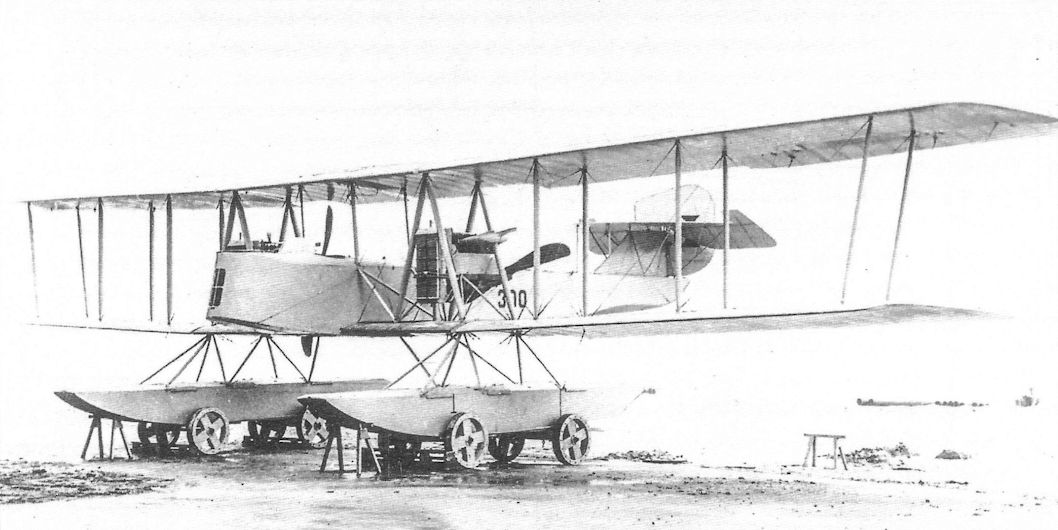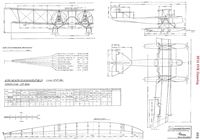O.Thetford, P.Gray German Aircraft of the First World War (Putnam)
Friedrichshafen FF 35
Built in February 1915, the FF 35 was intended as a torpedo carrier, but only a single machine (No. 300) was constructed. The twin 160 h.p. Mercedes D III engines drove pusher airscrews. Span, 23.74 m. (77 ft. 10 3/4 in.). Length, 13.5 m. (44 ft. 3 5/8 in.). Area, 100 sq.m. (1,080 sq.ft.). Weights: Empty, 2,292 kg. (5,042 lb.). Loaded, 3,543 kg. (7,795 lb.). Speed, 114 km.hr. (71.25 m.p.h.). Armament, torpedo and one or two manually operated Parabellum machine-guns.
Показать полностью
J.Herris Friedrichshafen Aircraft of WWI (A Centennial Perspective on Great War Airplanes 21)
Friedrichshafen Torpedo Bombers
Before WW1, relatively unsuccessful attempts to drop anti-ship torpedoes from aircraft were carried out in Italy, Great Britain, and the USA. No torpedo bombers were available in Germany, and a quick solution had to be found. The result was land airplanes were converted to carry torpedoes. Both LVG and Albatros built prototypes but tests soon revealed a distinct lack of success.
By the end of 1914 the German Navy defined the requirements for a new torpedo bomber. The crew should be two men and the aircraft should be able to carry a heavy, 700 kg torpedo. Flight endurance must be three to four hours. The German Navy sent development orders to several companies, including Albatros, Brandenburg, Gotha, and Friedrichshafen. As builder of the greatest number of floatplanes for the German Navy, Friedrichshafen was obviously interested in responding to the torpedo floatplane requirement.
Friedrichshafen FF35
Friedrichshafen's initial torpedo bomber design was the FF35 that was ordered in February 1915 handed over to the SVK more than a year later, on May 24, 1916, after a maiden flight earlier in 1916. This prolonged development time was due to the factory being fully employed in projects. Powered by a pair of 160 hp Mercedes D.III engines mounted as pushers, the FF35 was a conventional biplane floatplane. The engines were mounted in boxy nacelles with radiators at the front. The aft section was plywood for greater strength and the elevator was raised to protect it from sea spray. The main fittings were forged from steel. The aircraft was designed for a crew of three, a pilot and two gunners, one of whom was also the torpedo aimer. One aircraft, Marine Number 300, was built. Some records indicate a second FF35, Marine Number 310, was built, but official SVK records show only the first aircraft being ordered and delivered, with the block of Marine Numbers from 301-400 being left open.
Friedrichshafen Torpedo Bomber Specifications
Specification FF35 FF41a FF41at FF53
Engines 2x160 hp Mercedes D.III 2x150 hp Benz Bz.III 2x150 hp Benz Bz.III 2x260 hp Mercedes D.IVa
Span (Upper), m 23.74 22.00 22.00 -
Span (Lower), m 21.02 20.97 20.97 -
Length, m 13.50 13.70 13.70 -
Height, m 4.50 4.65 4.65 -
Wing Area, m2 100.00 112.50 112.50 -
Empty Wt., kg 2,292 2,300 2,288 -
Loaded Wt., kg 3,543 3,670 3,701 -
Max. Speed, km/h 114 125 121 -
Cruise Speed, km/h - 115 - -
Climb to 500 m - - 9 minutes -
Climb to 800 m - - 16-18 minutes -
Climb to 1,000 m - - 20-25 minutes -
Range, km 770 575 605 -
Crew 3 3 2 3
Armament 726 kg torpedo & 1-2 Parabellum guns 726 kg torpedo & 1 Parabellum gun 726 kg torpedo & 1 Parabellum gun -
Friedrichshafen Torpedo Bomber Production
Type FF35 FF41a Unknown* FF41at FF53
Quantity 1 1 1 8 3
Marine Numbers 300 678 735 996-1000 & 1208-1210 1663-1665
*This aircraft was powered by two 220 hp Benz Bz.IV engines. It was ordered in May 1916 and the order was cancelled on 18 November 1917.
Показать полностью
M.Schmeelke "Torpedo Los!" (Aeronaut)
German Torpedo Aircraft
Flugzeugbau-Friedrichshafen
Like Albatros, the Flugzeugbau-Friedrichshafen (FF) at Lake Constance, also approached the development of a torpedo aircraft with much hesitation. Following the RMA's January 1915 request, the SVK issued a catalog of requirements. With Friedrichshafen already operating at full capacity to fill contracts for their reliable seaplanes, production of the FF35 was delayed until February 2, 1916. On May 24, 1916, SVK testing runs were completed at Warnemunde. The performance of the FF35, which was equipped with two 160 HP Daimler-Mercedes D III engines, proved satisfactory; however, as a T-aircraft, it had already been surpassed by its competition in terms of engineering. It is doubtful the second FF35 (Navy No. 310) was actually built. The Navy purchased the FF35 (300) and placed it in service on bombing missions at Seeflugstation Angernsee beginning in May 1916. Furthermore, No. 300 served repeatedly as a test aircraft of the SVK. In September 1916, it was listed in the naval files with the BFTMG classification. This indicated the subsequent installation of a radio device.
<...>
Friedrichshafen Torpedo Bombers
Before WW1, relatively unsuccessful attempts to drop anti-ship torpedoes from aircraft were carried out in Italy, Great Britain, and the USA. No torpedo bombers were available in Germany, and a quick solution had to be found. The result was land airplanes were converted to carry torpedoes. Both LVG and Albatros built prototypes but tests soon revealed a distinct lack of success.
By the end of 1914 the German Navy defined the requirements for a new torpedo bomber. The crew should be two men and the aircraft should be able to carry a heavy, 700 kg torpedo. Flight endurance must be three to four hours. The German Navy sent development orders to several companies, including Albatros, Brandenburg, Gotha, and Friedrichshafen. As builder of the greatest number of floatplanes for the German Navy, Friedrichshafen was obviously interested in responding to the torpedo floatplane requirement.
Friedrichshafen FF35
Friedrichshafen's initial torpedo bomber design was the FF35 that was ordered in February 1915 handed over to the SVK more than a year later, on May 24, 1916, after a maiden flight earlier in 1916. This prolonged development time was due to the factory being fully employed in projects. Powered by a pair of 160 hp Mercedes D.III engines mounted as pushers, the FF35 was a conventional biplane floatplane. The engines were mounted in boxy nacelles with radiators at the front. The aft section was plywood for greater strength and the elevator was raised to protect it from sea spray. The main fittings were forged from steel. The aircraft was designed for a crew of three, a pilot and two gunners, one of whom was also the torpedo aimer. One aircraft, Marine Number 300, was built. Some records indicate a second FF35, Marine Number 310, was built, but official SVK records show only the first aircraft being ordered and delivered, with the block of Marine Numbers from 301-400 being left open.
Friedrichshafen Torpedo Bomber Specifications
Specification FF35 FF41a FF41at FF53
Engines 2x160 hp Mercedes D.III 2x150 hp Benz Bz.III 2x150 hp Benz Bz.III 2x260 hp Mercedes D.IVa
Span (Upper), m 23.74 22.00 22.00 -
Span (Lower), m 21.02 20.97 20.97 -
Length, m 13.50 13.70 13.70 -
Height, m 4.50 4.65 4.65 -
Wing Area, m2 100.00 112.50 112.50 -
Empty Wt., kg 2,292 2,300 2,288 -
Loaded Wt., kg 3,543 3,670 3,701 -
Max. Speed, km/h 114 125 121 -
Cruise Speed, km/h - 115 - -
Climb to 500 m - - 9 minutes -
Climb to 800 m - - 16-18 minutes -
Climb to 1,000 m - - 20-25 minutes -
Range, km 770 575 605 -
Crew 3 3 2 3
Armament 726 kg torpedo & 1-2 Parabellum guns 726 kg torpedo & 1 Parabellum gun 726 kg torpedo & 1 Parabellum gun -
Friedrichshafen Torpedo Bomber Production
Type FF35 FF41A Unknown* FF41AT FF53
Quantity 1 1 1 8 3
Marine Numbers 300 678 735 996-1000 & 1208-1210 1663-1665
* This aircraft was powered by two 220 hp Benz Bz.IV engines. It was ordered in May 1916 and the order was cancelled on 18 November 1917.
Показать полностью
Журнал Flight
Flight, October 16, 1919.
SOME FRIEDRICHSHAFEN "MILESTONES"
Figs. 17 and 18 show
"the F.F. 35
which was fitted with two Mercedes engines of 150 h.p. each. This was the first twin-engined seaplane turned out by the Friedrichshafen Aircraft Works. One of the features of this machine was the method of mounting the engines. As will be seen from the illustrations (Figs. 17 and 18), the engines were supported by a framework of struts from the bottom plane, and the engine mounting is independent of the wing truss. The stern of the fuselage was built of three-ply wood, and had a Vee bottom m order to act as a tail float, the Vee bottom lessening the shock of the tail coming in contact with a rough sea. In order to protect the tail plane and elevator against the sea the tail plane is mounted on top of the vertical fin and braced by struts. During a number of flights the 35 has proved itself a very good machine. Another remarkable feature of this machine is that all metal fittings in the wings, fuselage and floats were made from solid steel by forging, milling, drilling and planing. Starting handles were provided in front of the radiators.
Показать полностью









